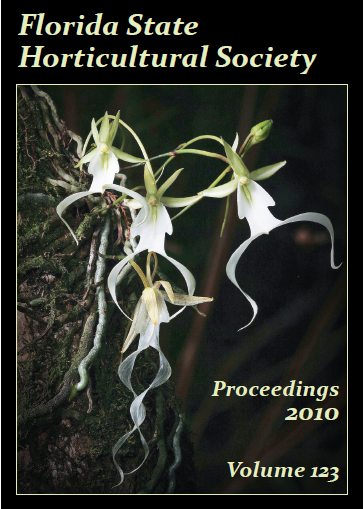Krome Memorial Institute (Tropicals)
Screening of Fruit Rot Diseases in Muscadine Grape (Vitis rotundifolia Michx.)
Published 2010-12-01
Keywords
- Vitis rotundifolia,
- disease resistance,
- black rot,
- bitter rot,
- macrophoma rot
Abstract
Muscadine grape (Vitis rotundifolia Michx.) is one of the major fruit crops in Florida. Although far more resistant to most diseases than bunch grapes (Vitis vinifera, Vitis labrusca, or their derivatives), muscadine grape suffers extensive economic losses every year due to fruit berry rotting diseases that significantly reduce fruit yield and marketability for both wine and fresh consumption. Three berry rot diseases, including black rot (Guignardia bidwellii f. muscadinii), bitter rot (Greeneria uvicola), and macrophoma rot (Botryosphaeria dothidea) were evaluated in 45 commercially available muscadine cultivars at the research vineyard of Florida A&M University in order to develop a disease-resistant breeding program. The cultivars were randomly arranged in three blocks and data were collected in five randomly picked clusters on each tree according to Kummuang et al. (1996) in the 2009 harvesting season. The results indicated that bitter rot was the most prevalent fruit rot disease that occurred on 29 muscadine grape cultivars, followed closely by black rot. The incidence of macrophoma rot was low. The most susceptible cultivar to bitter rot and black rot diseases was ‘Early Fry’ with 33.33% and 17.65% berry infection rate, respectively. Twelve cultivars showed no symptoms of bitter rot, black rot, and macrophoma rot diseases. They are ‘Alachua’, ‘Albermarle’, ‘Black Beauty’, ‘Digby’, ‘Fry’, ‘Granny Val’, ‘Golden Isle’, ‘Higgins’, ‘Noble’, ‘Pride’, ‘Sterling’, and ‘Supreme’. Co-occurrence of ripe rot on the same berry often makes identification of bitter rot more difficult, especially during the later harvest season.References
- Cline, B. and C. Fisk. 2006. Overview of muscadine acreage, cultivars and production areas in the southeastern US. Southern Region Small Fruit Consortium. NC Winery & Grape. <http://www.smallfruits.org/CoAgentTraining/Sept06Training/No1Muscadine_acres_and_cultivars.pdf>.
- Kummuang, N., S.V. Diehl, B.J. Smith, and C.H. Graves, Jr. 1996a. Muscadine grape berry rot disease in Mississippi: Disease epidemiology and crop reduction. Plant Dis. 80(3):244–247.
- Kummuang, N., B.J. Smith, S.V. Diehl, and C.H. Graves, Jr. 1996b. Muscadine grape berry rot disease in Mississippi: Disease identification and incidence. Plant Dis. 80(3):238–243.
- Lu, J., L. Schell, and D.W. Ramming. 2000. Interspecific hybridization between Vitis rotundifolia and Vitis vinifera and evaluation of the hybrids. Acta Hort. 528:479–486.
- Musingo, M.N., C.A. Sims, R.P. Bates, S.F. O’Keefe and O. Lamikanra. 2001. Changes in ellagic acid and other phenols in muscadine grape (Vitis rotundifolia) juices and wines during storage. Amer. J. Enol. Viticult. 52:109–114.
- Talcott, S.T. and J. Lee. 2002. Ellagic acid and flavonoid antioxidant content of muscadinewine and juice. J. Agr. Food Chem. 50:3186–3192.
- Yi, W., J. Fischer, and C.C. Akoh. 2005. Study of anticancer activities of muscadine grape phenolics in vitro. J. Agr. Food Chem. 53(22):8804–8812.

